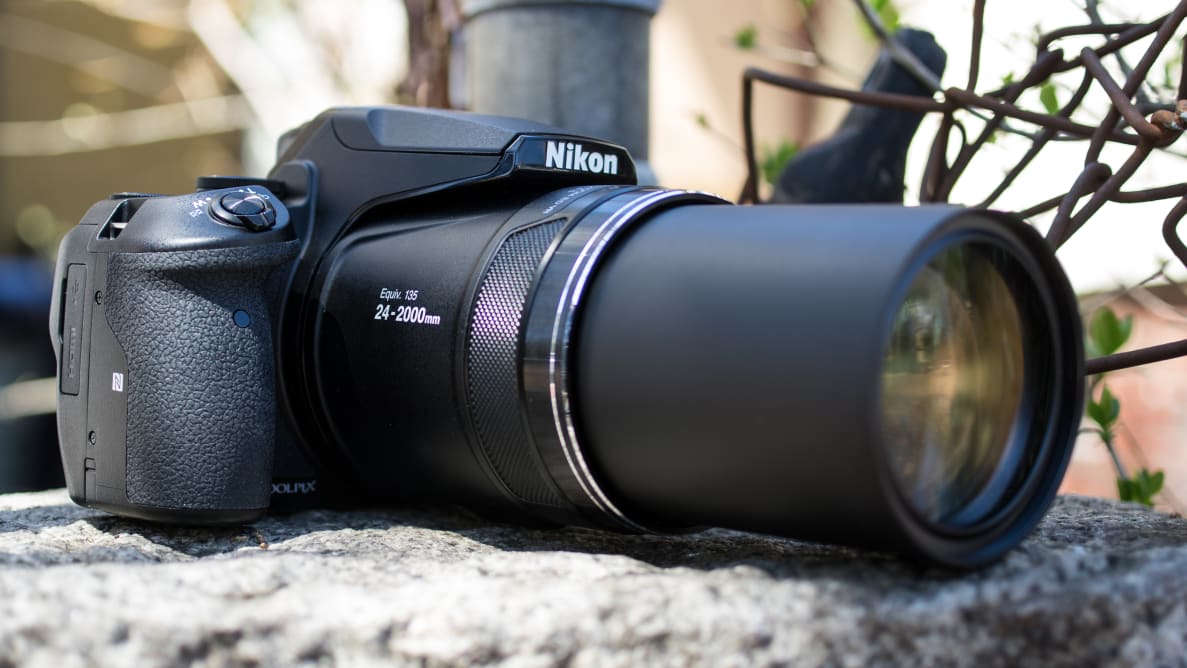Pros
-
Great for wildlife photography
-
Super high zoom
Cons
-
Struggles in low-light
Even so, Nikon decided that 50x just wasn't enough and pushed its new Coolpix P900 (MSRP $599.95) to a jaw-dropping 83x zoom (24-2000mm equivalent)–easily blowing away Canon SX60's longest ever 65x zoom. With a range like that, there isn't a shot that the P900 can't cover.
That kind of zoom can do wonders for people shooting anything from wildlife to the moon, but it does come with drawbacks. Steadying shots at 2000mm can be nearly impossible, even with Nikon's built-in image stabilization, and image quality suffers badly at full zoom. However, if you're looking for a camera that can reach out and snag a shot of just about any subject that you can lay your eyes on, the P900 has you covered.
Design & Handling
Like many superzoom cameras, the P900 is designed with a classic DSLR-style grip, but with a massive fixed lens on the front. Due to the P900's extreme lens, it's slightly larger than other bridge cameras–even the Panasonic FZ1000, which features a 1-inch sensor. Even the flash has to be built a bit differently; because the lens barrel is so long, Nikon has made an enormous flash that towers over the camera so the lens doesn't block the light.
{{ photo_gallery name="Tour" fullscreen="true" }}
Even with its increased size, the P900 feels well built and not too front-heavy. This is mostly due to the deep grip and tactile leather-like material that covers it. However, when you're zoomed to 2000mm, two hands are absolutely required if you want any hope of getting a steady shot. Still, it's light enough the you can hold it in one hand–something you couldn't do if it were a DSLR.
The button layout is fairly standard for a Nikon point-and-shoot. The top controls include a zoom lever around the shutter release, power switch, function button, as well as both a command and mode dial. The rear controls are in a basic array and include dedicated buttons for WiFi and recording video. The side of the lens has an additional zoom lever and a snap-back zoom button.
{{ photo_gallery name="design" fullscreen="true" }}
The rear LCD does flip out and swivel, which is very useful when shooting overhead or at other tough angles. That said, it's not the best LCD. It's also not a touchscreen, but at this price point, with an 83x zoom, you can't expect everything.
Performance
Designing a camera with a 24-2000mm equivalent zoom is an exercise in compromise. The P900 takes quite a few hits to its performance for the ability to reach out and touch the stars. That's not to say that it won't provide quality that's acceptable for people that want the absolute longest zoom on the market. But if you're looking for something to give professional quality images at 2000mm, the P900 is going to be a letdown.
Let's start with explaining how the sensor relates to the lens and its zooming ability. The 1/2.3-inch sensor gives the P900 a 5.6x crop factor and allows it to reach the 2000mm mark. If Nikon wanted to get better quality, it would have to use a larger sensor, which would mean dealing with an even larger lens. Obviously you can't make the lens much larger, so Nikon is stuck with this small sensor that you'd find in any other point-and-shoot.

EXIF: 1400mm, 1/500, f/ 6.3, ISO 140
This small sensor limits both resolution and low-light performance. The P900 is capable of taking shots at an amazing range of focal lengths, but the further out you go, the worse the quality becomes. The wide angle shots aren't too bad, but once you get out toward the telephoto end of the focal range, the images are pretty much only good for social media posts due to grain and overall softness.
Another issue that stems from the small sensor is high-ISO performance. This comes in play in two different ways. The most obvious was is in low-light, when you need to bump up the ISO to properly expose the scene. These shots will look grainy, though you should be able to use most of the ISO range thanks to noise reduction. The other issue comes from shooting handheld shots at long focal lengths. When you're shooting at 1000mm plus, you're going to need a very fast shutter. That might mean bumping up your ISO even when it's light out, which results in a loss of even more detail. I wouldn't recommend venturing far above ISO 800.
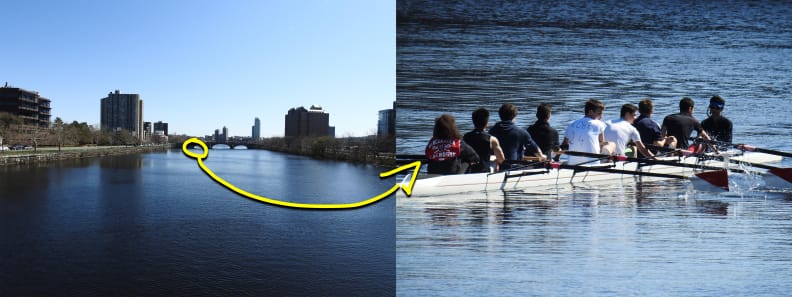
Maybe this can put the amount of zoom the P900 has into perspective. Shots taken at 24mm (left) and 2000mm (right).
Video quality is also a victim of the small sensor. Frankly, the video captured on the P900 is underwhelming even under perfect lab conditions. I suppose if you absolutely need the zoom, it's a good reason to pick it up. However, if you absolutely need to zoom in 2000mm for video, I have to question what you're filming. Otherwise, you can pick up dozens of cameras or camcorders in this price range that will produce superior footage and give you decent zooming capabilities.
Shooting Experience
Shooting with the P900 was surprisingly pleasant. I'm not usually a fan of shooting with bridge cameras–especially one that I knew was going to lack the sharpness and performance I would be happy with–but the P900 wasn't terrible. This isn't to say that it performed up to my liking when I got the images to my computer, but the process of capturing the images was, dare I say, enjoyable.
{{ photo_gallery name="Samples" fullscreen="true" }}
The controls are very straight forward and have almost no learning curve for anyone that's used either a DSLR or compact point-and-shoot. I do wish the buttons had a little more feedback to them, though. A few times I wasn't sure if I pressed anything, especially the record button, due to the combination of slow response time and lack of tactile feedback. The top and rear command dials are also a bit on the loose side and rotate a bit too easily for my liking.
The EVF isn't amazing, but it isn't the worst thing I've looked through either. I did find myself using the LCD more than I usually do when shooting wide shots–only switching to the EVF for longer focal lengths. For the price you're paying for the P900, the EVF and LCD are no slouches.
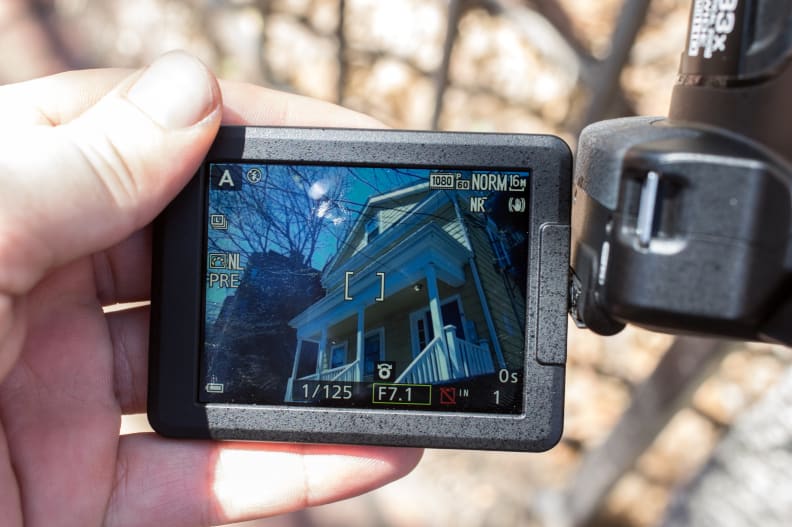
The LCD flips out and swivels to help shooters get around awkward shooting angles.
On the subject of longer focal lengths, the camera zooms very slowly. Granted it has a lot of zoom to cover, but if you're hoping to snap to 2000mm quickly, you'll be disappointed. On average it took 6.3 seconds to go from 18mm to 2000mm, which is plenty of time to lose that perfect moment. One useful feature is the "snap-zoom" feature. It works when you're zoomed in on a subject, automatically zooming out momentarily, allowing you to find your subject. It then snaps back so you're ready to fire away.
Conclusion
To be honest, I was surprised by how much I didn't mind shooting with the P900. However, the images—while okay-looking at small sizes—were never really as good as I wanted them to be on closer inspection. I can see how it's appealing for some people to be able to take a wide angle shot of a canyon and be able to take a sniper shot of a bird on a tree branch all the way across that same canyon–without switching cameras or lenses. However, the quality of that bird shot is going to suffer too much, in my opinion.
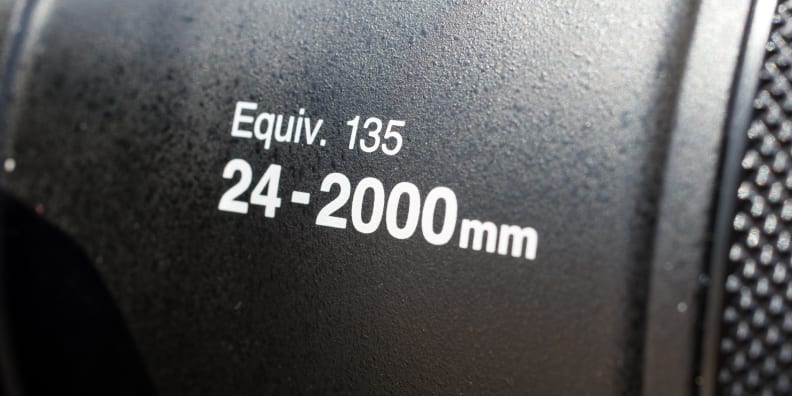
Honestly, you're probably better off with a better camera with less zoom. If you're looking for a camera that has enough zoom for almost everyone, take a look at Panasonic's FZ1000. It has a 24-400mm lens that ranges from f/2.8-4 (much faster than the P900) and a bigger 1-inch sensor. This combination gives you far superior image quality, low-light performance, and 4K video–all for only around $100 more.
Of course, we know that some people are already in love with the idea of a 2000mm zoom. Just be aware that the images will not rival what you see in National Geographic. In fact, they might not even rival what you see from your local high school paper. It's going to struggle in low-light, especially if you start zooming in, with mediocre video quality in the best circumstances. The only saving grace is that it's a darn fun camera to use. But for a $600 camera that's just not enough anymore.
Hopefully the battle for longest superzoom will finally start to slow down in this category–as it did with megapixels. I can't think of too many reasons to justify needing a 2000mm zoom, but if you're a bird watcher and need a pair of binoculars that occasionally works like a camera, the P900 is worth a go. Aside from that, I'd recommending picking up a shorter superzoom that produces better quality images.
By the Numbers
The P900, while equipped with an impressive zoom, comes up a bit short in the raw performance department. Resolution, low-light performance, and video all suffer from the combination of a small sensor and extremely long zoom. It will serve a niche group of people that need the 2000mm zoom well enough, but people that don't absolutely need it should look elsewhere.
Color and White Balance
One area that the P900 did excel was color accuracy. The most accurate mode, Neutral, posted a ∆C 00 (saturation corrected) error of 2.13, with an overall saturation of 87.6%. That is a little desaturated for our liking, but you can use the Vivid or Standard modes if you want a little more pop.
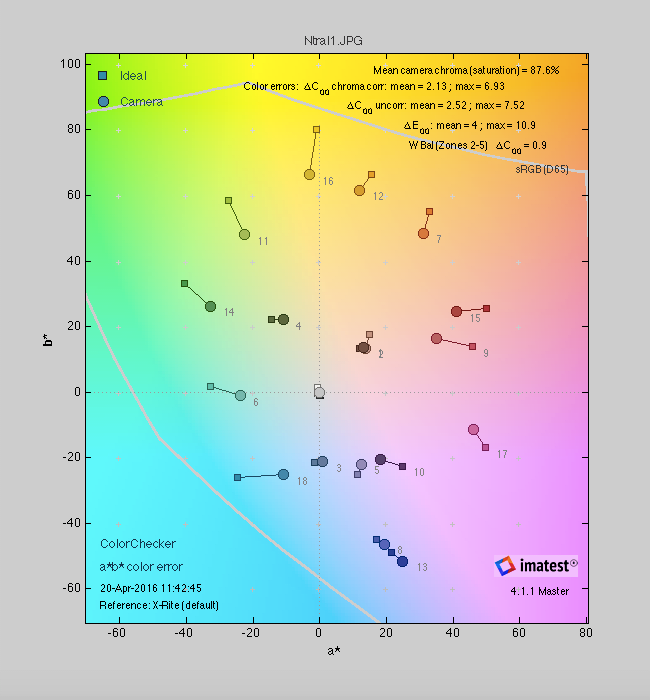
White balance was very accurate while using both auto and custom settings. The P900 did, like many cameras, struggles with incandescent. Unfortunately you can't shoot RAW with the P900 so fixing the white balance in post is largely out of the question. I'd recommend using custom white balance whenever possible.
Resolution
Resolution on a small sensor, big lensed camera is going to be tough, and the P900 is no different. While shooting wide, you'll get some pretty crisp images. But once you get past the halfway point, sharpness drops aggressively. You can shoot at the full 2000mm, but the images won't be good for much more than sharing online or in small formats.
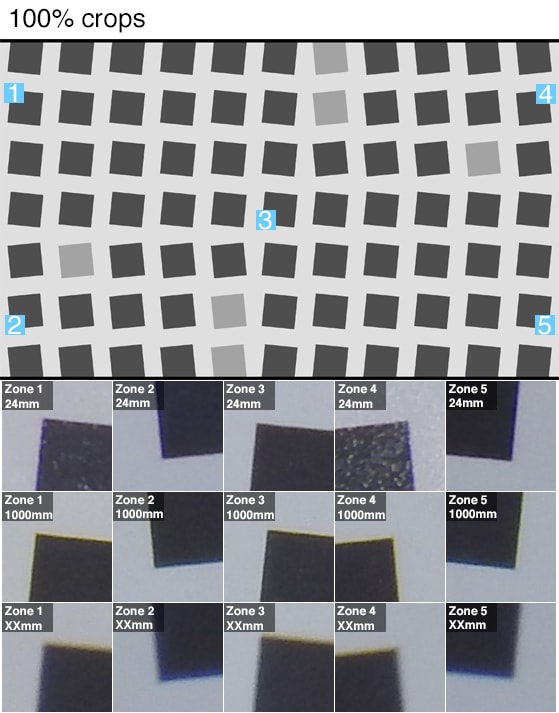
If you look at the chart above you can see how the dip in resolution happens as you make your way through the focal range. Not to mention shooting at 2000mm required fast shutter speeds and steady hands. We shot these on a tripod and the slightest movement resulted in disaster for framing.
Video
Video suffers much like stills due to the small sensor, long lens combination. We shot video at the widest angle–to ensure the sharpest result–and we still only recorded around 350 line pairs per picture height (LP/PH) horizontally and 375 LP/PH vertically. To put that into context, most cameras in this price range (that also shoot 1080p video) hit around 500+ LP/PH.
Dropping to low-light (60 lux) only took away more details dropping an additional 50 LP/PH both vertically and horizontally. Low light sensitivity was abysmal as well, requiring a whopping 33 lux of light to produce useable footage. Most cameras now days can at least drop under 10 lux.
Meet the tester
As a photojournalist, Jackson has had stints working with bands, the military, and professional baseball teams before landing with Reviewed. Outside of Reviewed, he can be found looking for the next game to relieve his "Gamer ADD" or growing his beard.
Checking our work.
Our team is here to help you buy the best stuff and love what you own. Our writers, editors, and experts obsess over the products we cover to make sure you're confident and satisfied. Have a different opinion about something we recommend? Email us and we'll compare notes.
Shoot us an email